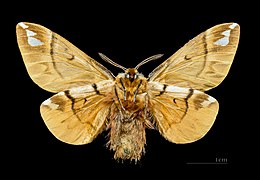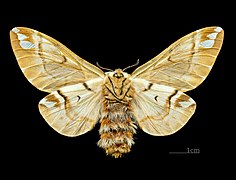zh-TW
在導航的名稱


Endromis is a monotypic moth genus in the family Endromidae erected by Ferdinand Ochsenheimer in 1810. Its only species, Endromis versicolora, the Kentish glory, was described by Carl Linnaeus in his 1758 10th edition of Systema Naturae. It is found in the Palaearctic region.
The wingspan is 50–70 mm. The adults fly from March to May. Females are much larger and paler than males and fly only at night in order to lay eggs. Males, which fly both by night and day, can detect female pheromones from a distance up to 2 km.
Yellow at first, then purplish-brown eggs are laid in two or three rows around a thin birch branch. After 10 to 14 days little black caterpillars hatch.
The caterpillars primarily feed on birch (Betula species), but accept other trees and shrubs: Alnus, Corylus, Tilia and Carpinus species. It is green with paler stripes. At first it feeds in small groups of 15 to 30 larvae, but mature caterpillars feed individually and only at night.
Endromis versicolora has a single generation per year; it overwinters as a pupa in a thin loose strong cocoon buried shallowly in the soil.
Male dorsal side, MHNT
Endromis is a monotypic moth genus in the family Endromidae erected by Ferdinand Ochsenheimer in 1810. Its only species, Endromis versicolora, the Kentish glory, was described by Carl Linnaeus in his 1758 10th edition of Systema Naturae. It is found in the Palaearctic region.
 Illustration from John Curtis's British Entomology Volume 5
Illustration from John Curtis's British Entomology Volume 5  Fig3, 3a larvae after last moult 3b pupa
Fig3, 3a larvae after last moult 3b pupa The wingspan is 50–70 mm. The adults fly from March to May. Females are much larger and paler than males and fly only at night in order to lay eggs. Males, which fly both by night and day, can detect female pheromones from a distance up to 2 km.
Yellow at first, then purplish-brown eggs are laid in two or three rows around a thin birch branch. After 10 to 14 days little black caterpillars hatch.
The caterpillars primarily feed on birch (Betula species), but accept other trees and shrubs: Alnus, Corylus, Tilia and Carpinus species. It is green with paler stripes. At first it feeds in small groups of 15 to 30 larvae, but mature caterpillars feed individually and only at night.
Endromis versicolora has a single generation per year; it overwinters as a pupa in a thin loose strong cocoon buried shallowly in the soil.

Male dorsal side, MHNT

Male ventral side, MHNT

Female dorsal side, MHNT

Female ventral side, MHNT
Endromis versicolora
Le Bombyx versicolore ou le Versicolore, Endromis versicolora, est une espèce de lépidoptères (papillons) de la famille des Endromidae. Elle est l'unique représentante du genre monotypique Endromis.
Les papillons mâles ont une longueur de l'aile antérieure (LAA) de 25 à 30 mm. Ils sont actifs de jour.
La chenille est vert vif avec des bandes latérales claires et une saillie pointue sur le 8e anneau abdominal.
L'espèce est univoltine, avec une période de vol allant de mars à mai. L'adulte ne se nourrit pas.
Les plantes hôtes sont des Betula, Corylus, Tilia, Alnus, etc.
L'espèce est répandue sur une aire allant de l’Ouest de l’Europe à l’Est de la Sibérie[1].
Ses habitats sont les forêts de bouleaux.
L'espèce actuellement appelée Endromis versicolora a été décrite par le naturaliste suédois Carl von Linné en 1758, sous le nom initial de Phalaena versicolora[1]. Elle est l'espèce type et unique espèce du genre monotypique Endromis, décrit par l'entomologiste allemand Ferdinand Ochsenheimer en 1810[1].
Il existe une sous-espèce particulière dans le Caucase et en Anatolie : Endromis versicolora eichleri Alberti, 1975[2].
Endromis versicolora
Le Bombyx versicolore ou le Versicolore, Endromis versicolora, est une espèce de lépidoptères (papillons) de la famille des Endromidae. Elle est l'unique représentante du genre monotypique Endromis.
Endromis é um gênero de mariposa pertencente à família Endromidae.[1]
Endromis é um gênero de mariposa pertencente à família Endromidae.